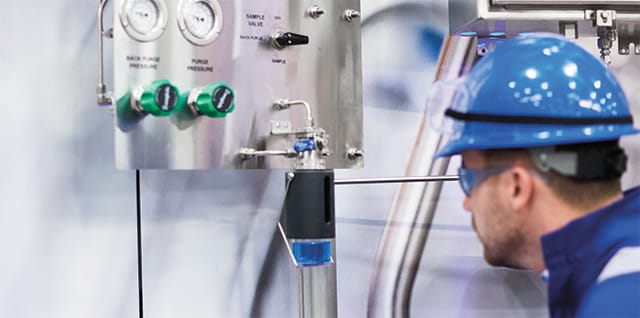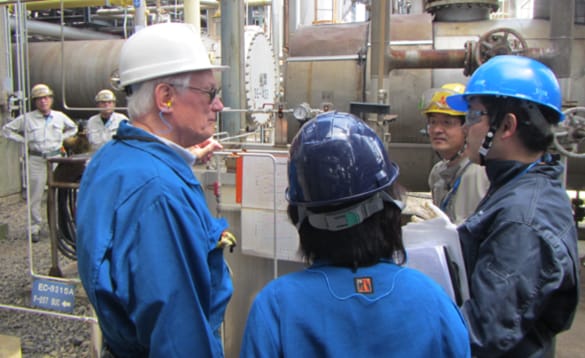Sample System Design

Sample System Design 101
Written by: Brian Aplin, Field Engineer | November 2020
Ensuring Compatibility
Process analyzers cannot always accept a sample directly from a process tap. In many cases, the sample must be conditioned for the analyzer to accept it. The sample conditioning system is the physical assembly of fluid-processing components used to ensure the sample is compatible with the analyzer being used. Aside from material compatibility, the sample conditioning system needs to account for and control pressure, temperature, and flow of the sample. This system should also protect the analyzer from any process upsets.
Time Delay
Ensuring sample compatibility is only one part of the system designer’s responsibility. You must also ensure that the sample reaches the analyzer in a timely manner so that it is representative of the process. However, consideration of how the sample measurement will be used is also critical in determining what an acceptable response time is. Some general rules of thumb for ensuring a short response time include:
- Reduce length of sample transport lines
- In gas systems, reduce the pressure at the process tap
- In liquid systems, maintain pressure in the transport system
- Minimize mixing volumes such as filters and knockout pots
- Move dead legs to bypass lines
- Avoid changing state of liquid or gas samples if possible
Representative Sample Results
A representative sample will either indicate efficient process operation or that an undesired deviation has occurred in the process. Ensuring a sample is representative will begin with understanding acceptable time delay, which we have already considered. The following must also be considered in obtaining a representative sample:
- Contamination – any loss of analyte molecules or addition of alien molecules to the sample
- Valve Leakage – one of the most common sources of sample contamination is seepage through “closed” valves. In order to prevent such contamination, consider utilizing a modified double block and bleed valve layout. Two valves will close to stop flow while the third “bleed” will open to allow flow between the two valves to a low-pressure vent. Any valve leakage will flow to this vent preventing contamination of other samples.
- Dead Legs – not only will a dead leg increase time delay, a dead leg also will contain old sample. While much of this old sample is eventually flushed away, a dead leg will have a constant contamination rate of about 0.1%.
- Adsorption – removal of molecules from the sample, changing its composition. The worst offenders of sample adsorption are fibrous filter elements.
- Permeation – The passage of molecules through the walls of tubing driven by a partial pressure difference across the tube wall. Molecules move to where there are less of them and Molecules behave as if the other molecules are not there. This means that molecules will not only exit the system, but molecules form the environment will tend to enter the system as well. Generally, metal tubes will not permeate, whereas all plastic tubing is susceptible to permeation.
- Condensation, Fractionation, and Chemical Reactions – condensing of gas samples or boiling of liquid samples (fractionation) will render a sample unusable for analysis. This is because the vapor and liquid will have different compositions, and neither are representative of the process. The same is true if a sample is taken while a reaction is taking place. If a sample must be taken to monitor a process reaction, consider a downstream location, allowing the process to quench the reaction.
System Safety and Reliability
Aside from the potential hazards of your process chemicals being at high temperatures and pressures, your analyzers carry inherent risks to the safety of personnel as well. Some process analyzers, such as X-Ray fluorescence or nuclear absorption, present Radiation Hazards that users must be aware of while others utilize furnaces that burn at extreme temperatures that not only present a burn hazard, but an ignition hazard as well. You will also need to keep in mind electrical codes and requirements of plant areas where these process analyzer systems will be installed and located.
Increasing system reliability begins with system design. The more simplistic a system can be designed, the more reliable it tends to be. One common culprit of system complexity is utilization of one analyzer for multiple process sample streams. Documentation of the sample system design is essential for the maintenance and care of the system along with proper training of engineering and maintenance personnel. Swagelok offers Process Analyzer Sampling System Design training along with Maintenance training, depending on the needs of your facility.
Learn more about Process Analyzer Sampling System (PASS) Training
Learn more about Sampling System Problem Solving and Maintenance (SSM)
Sources:
Industrial Sampling Systems: Reliable Design & Maintenance for Process Analyzers; CH 2, Tony Waters, 2013

